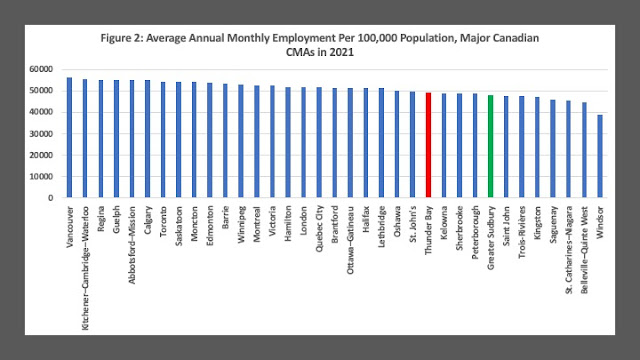Thunder Bay even during the trade war has been doing quite
well. Population is up as is total employment
in the wake of the pandemic. While the
national unemployment rate in August of 2025 was 7.1 percent and Ontario
clocked in at 7.7 percent, Thunder Bay was below both at 5 percent. Moreover, employment grew from 65,300 in July
to 66,400 in August which incidentally is one of the highest the highest monthly
total employment amounts in 20 years.
While Thunder Bay has seen ebbs and flows over time, there has been a distinct
upward trend in total employment since about 2012 marking the end of what could
be termed the early 21st century lost decade as the forest sector
crisis ravaged the local and regional economy.
Figure 1 plots monthly total employment obtained from assorted
Statistics Canada series from 1987 to 2025.
It also fits a LOWESS non-parametric smoothing curve to highlight the
trends in total employment. The early
years of the first decade of the 21st century saw total employment
in Thunder Bay rise as the recessionary 1990s were left behind and the all-time
peak employment of 67,400 jobs reached in July of 2003. Soon after began the shocks and declines of
the forest sector crisis began to accumulate and employment trended downwards
until 2012.
Thunder Bay’s economy transformed in the aftermath of the
forest sector crisis as it moved into knowledge economy jobs as well as saw the
expansion of the regional mining sector.
Indeed, despite the ebbs and flows, the period since 2012 is the longest
continuous upward trend in employment in this nearly 40-year period. However,
despite this good news, total employment in August 2025 still falls short of
previous peaks reached in July 2003(67,400), June 2018 (66,200) and April 2023
(67,100). Indeed, Thunder Bay’s best employment performances historically have
always oscillated within a band of 65,000 to 68,000 jobs. This band has never been exceeded and until
it is one can argue that Thunder Bay remains strangely constrained in a situation
of bounded economic ability.
The other interesting point in all this that I came across
while cleaning out files was a 2005 Major Employer List out by the Thunder Bay
Community Economic Development Corporation.
Sadly, they no longer seem to have such as list on their web site as I could
not locate either the old ones or an updated version. Nevertheless, the list is compelling documentation
of the world that we have lost. Thunder
Bay is intriguing in the sense that over time one is faced with the dual reality
that there has been both major economic change and no change whatsoever.
Figure 2 plots the major employers in 2005 ranked from
highest to lowest. Highlighted in red
are all the employers that to the best of my knowledge are no longer with
us. In 2005 the list has 55 employers
with then largest being the City of Thunder Bay (3,080 employees) and the
smallest being DST consulting Engineers and Loch Lomond Ski Resort (both at 100
employees each). Interestingly, the top ten employers on this list are all
still with us showing the amazing continuity that is often Thunder Bay despite all
the change that has occurred.
This list of major employees added up accounts for 29,320
employees with average total monthly employment in Thunder Bay in 2005 at
64,000. Notable by their absence is any
of the grain elevator companies but these had been hollowed out in the 1980s
and 1990s and to my knowledge there could not have been more than 300-400
workers left in that sector. Then there is
TBayTel which easily has several hundred employees also, but it is possible
that they are under the municipal total. Nevertheless, if you add these jobs too,
then this list was essentially the city’s economic high ground with nearly 50 percent
of employment.
Since 2005, Thunder Bay’s economy lost several major employers. Gone are Buchanan Group Northern Wood (550
employees), Cascades Fine Papers Group Thunder Bay Inc. (550 employees),
Abitibi Consolidated (down to 400 by 2005 after other closures), Buchanan Group
Great West Timber (290 employees), Buchanan Northern Hardwoods (200 employees),
Zellers (368 employees), Sears Canada (300 employees) and OPG Generating
Station (150 employees)for a total of 2,518 jobs. The last three employers mentioned
went later than the forest sector companies with Zellers departing 2013 (it was
a national departure), Sears Canada (2018, another national departure) and OPG Generating
more recently.
Between 2005 and 2010, average annual monthly total
employment went from 64,000 to 59,800 as associated multiplier effects worked
in reverse affecting retailers, suppliers and other services. Thunder Bay itself lost about 5,000 jobs
during this period – many high paying resource sector jobs - an upheaval that essentially
ended a way of middle-class life for many families. The fact that Thunder Bay is currently back
to 66,400 jobs is a remarkable achievement given that it means that nearly
7,000 jobs have been created since the forest sector crisis low point. In other words, the 5,000 lost jobs have been
made up – in quantity of not always quality – with growth of an additional 2,000
jobs. This is good news.
Crucial to the remainder of this decade will be continued
growth in Thunder Bay’s economy that boosts employment well above its historic
65,000 to 68,000 glass ceiling.































